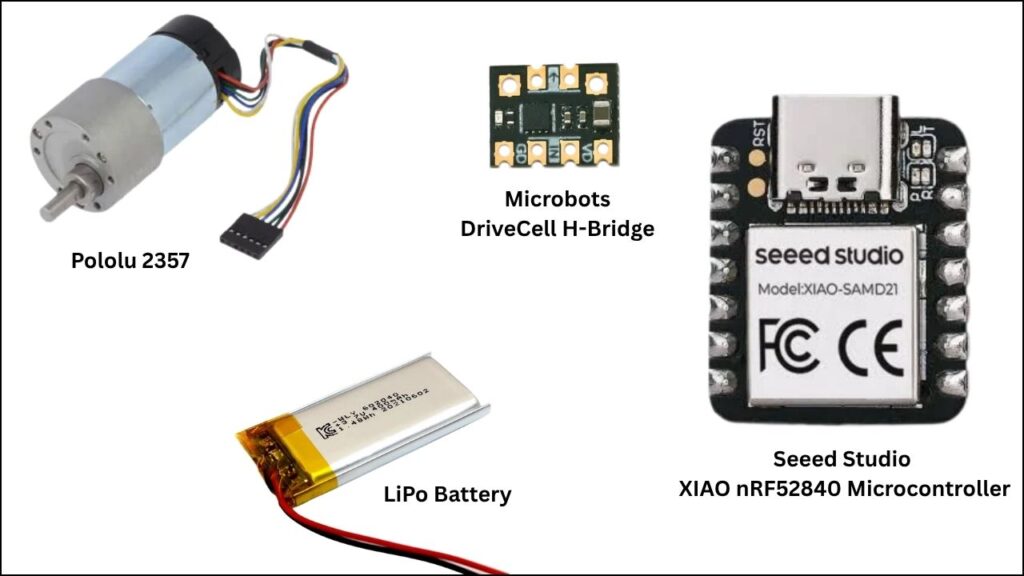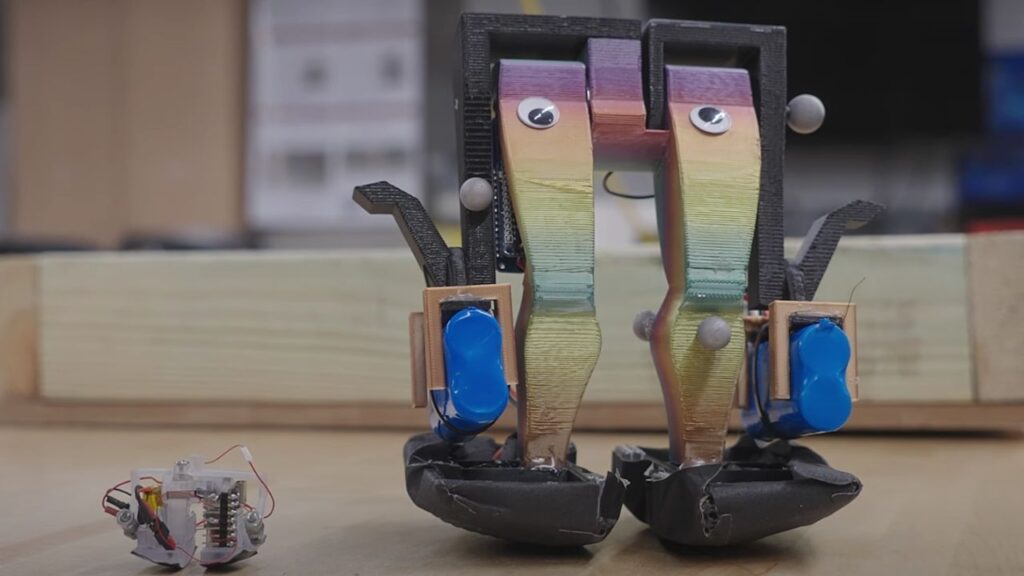Small Self-Powered Walking Robot Achieves New Movement Benchmark: In the world of robotics, the phrase “big things come in small packages” has never rung truer. Enter Zippy, the world’s smallest self-powered walking robot, which has just set a new benchmark for movement speed and agility in microrobotics. Developed by a talented team at Carnegie Mellon University (CMU), Zippy is not only a technological marvel for its size but also a glimpse into the future of robotics for rescue, inspection, and exploration.

Zippy’s story is about more than just breaking records. It’s about how tiny, energy-efficient robots can transform industries, help save lives, and even inspire the next generation of engineers and scientists.
Table of Contents
Small Self-Powered Walking Robot Achieves New Movement Benchmark
| Feature/Fact | Details |
|---|---|
| Robot Name | Zippy |
| Height | 3.6 cm (1.5 inches) |
| Weight | 25 grams (0.9 oz) |
| Movement Speed | 10 leg lengths per second (≈25 cm/s or 19 mph scaled to human size) |
| Power Source | Onboard LiPo battery |
| Control System | Single DC motor, open-loop control, Seeed Studio XIAO nRF52840 microcontroller |
| Key Abilities | Walking, turning, skipping, climbing small steps |
| Potential Applications | Search and rescue, industrial inspection, scientific exploration |
| Developed By | Carnegie Mellon University (Aaron Johnson, Sarah Bergbreiter, Steven Man, and team) |
| Official Website | Carnegie Mellon University College of Engineering |
| Notable Benchmark | Fastest power-autonomous bipedal robot by body-lengths-per-second |
| Future Plans | Sensor integration, swarm robotics, enhanced navigation |
Zippy, the world’s smallest self-powered walking robot, is more than just a record-breaker. It’s a shining example of how innovation, teamwork, and a focus on practical challenges can lead to technology that’s both fascinating and useful. Whether you’re a child dreaming of building robots or a professional seeking smarter solutions, Zippy’s journey offers inspiration, lessons, and a glimpse into the future of robotics.
What Makes Zippy Special?
Breaking Down the Innovation
Zippy stands out for several reasons:
- Tiny but Mighty: At just 3.6 cm tall—about the height of a LEGO minifigure—Zippy is the smallest self-contained bipedal robot ever built.
- Record-Breaking Speed: Zippy can walk at a rate of 10 leg lengths per second. To put that in perspective, if a human could do the same, it would be like walking at 19 miles per hour—faster than most people can run.
- Self-Powered: All of Zippy’s components, including its battery, motor, and control system, are packed into its tiny frame. There are no wires or external power sources holding it back.
- Agile and Versatile: Zippy can not only walk forward but also turn, skip, and climb small steps. This makes it ideal for navigating tight, cluttered, or hazardous environments where larger robots simply can’t go.
How Does Zippy Walk?
Zippy’s walking mechanism is a marvel of simplicity and efficiency:
- Passive Dynamic Walking: Instead of relying on complex motors and sensors, Zippy uses a single motor at its hip and specially shaped feet. It lifts its front leg, shifts its weight forward, and lets momentum swing the other leg through for the next step.
- Mechanical Hard Stops: Unlike bigger robots that use servo motors for joint movement, Zippy uses a simple mechanical hard stop to limit its hip movement, reducing weight and complexity.
- Open-Loop Control: Zippy’s motor is controlled without real-time feedback, meaning it follows a set pattern rather than reacting to its environment. This keeps the design simple and lightweight, though it also means Zippy is more sensitive to disturbances.
The Technology Behind Zippy
Hardware Components

Zippy’s remarkable performance is thanks to its carefully chosen hardware:
- Seeed Studio XIAO nRF52840 Microcontroller: This tiny but powerful brain handles all motor control and will enable future upgrades like sensor feedback.
- Single DC Motor (Pololu 2357): Drives the entire walking motion with open-loop control.
- Microbots DriveCell H-Bridge: Controls the voltage to the motor, allowing precise movement.
- LiPo Battery: Provides all the power Zippy needs to operate independently.
- 3D-Printed Body: Lightweight, custom-designed legs, feet, and arms for optimal performance.
Design Principles
The team at CMU followed five key design rules, adapted from earlier robots, to ensure Zippy’s success:
- Center of Gravity: Must be below the center of curvature of the foot for stability.
- Hip Placement: The hip’s vertical position must be above the foot’s center of curvature.
- Hip Axis: In the walking direction (sagittal plane), the hip axis should be behind the center of gravity.
- Foot Gap: There must be a lateral gap between the feet for balance.
- Torque and Inertia: Sufficient to overcome friction and start walking.
These principles, combined with precise 3D printing and careful balancing, give Zippy its unique blend of speed, stability, and agility.
Why Does Zippy Matter? Real-World Applications

Emergency Search and Rescue
Imagine a building collapse or a natural disaster. Large robots and humans can’t squeeze through tiny gaps in rubble—but Zippy can. Its small size and agility make it a perfect candidate for search and rescue missions, where every second counts and reaching trapped victims quickly is crucial.
Industrial Inspection
Factories, pipelines, and power plants often have tight, hazardous spaces that need regular inspection. Zippy could autonomously patrol these areas, spotting problems before they become disasters—all without putting human workers at risk.
Scientific Exploration
From exploring ancient ruins to investigating hazardous geological sites, Zippy’s ability to navigate rough terrain and confined spaces opens up new possibilities for scientific research in places that were previously off-limits.
Practical Advice: How to Get Involved or Learn More
Whether you’re a student, hobbyist, or professional, Zippy’s story offers inspiration and practical lessons:
- For Students: Study the basics of robotics, electronics, and 3D printing. Try building simple robots using kits or open-source designs.
- For Educators: Use Zippy as a case study to teach principles of engineering, design, and problem-solving.
- For Professionals: Stay updated on advances in microrobotics. Consider how small-scale robots could solve challenges in your industry.
- For Hobbyists: Explore microcontroller platforms like the Seeed Studio XIAO nRF52840 and experiment with open-loop control systems.
For more technical details, visit the official website listed in the Key Highlights table above.
Step-by-Step Guide: How Zippy Walks
- Power Up: Zippy’s onboard battery supplies energy to its microcontroller and motor.
- Initiate Movement: The microcontroller sends a signal to the motor, which rotates the hip joint.
- Lift and Shift: The robot lifts its front leg and shifts its center of gravity forward.
- Swing Through: Momentum and the rounded foot design allow the rear leg to swing forward, completing a step.
- Repeat: The process repeats, allowing Zippy to walk, turn, or even climb small steps.
Energy-Efficient Quantum Amplifier Developed Without Loss in Performance
Engineers Test First Jet-Propelled Humanoid Robot With Controlled Flight
Physicist Resolves Long-Standing Thermodynamics Question and Refines Einstein’s Model
FAQs About Small Self-Powered Walking Robot Achieves New Movement Benchmark
How fast can Zippy move?
Zippy walks at 10 leg lengths per second, or about 25 cm/s. Scaled to human size, that’s like walking at 19 mph—faster than most people can run.
What powers Zippy?
Zippy is powered by a small onboard LiPo battery, making it fully autonomous and wireless.
How is Zippy controlled?
Currently, Zippy uses open-loop control, meaning its motor follows a set pattern without real-time feedback. Future versions may include sensors for smarter navigation.
What are Zippy’s main applications?
Potential uses include search and rescue, industrial inspection, and scientific exploration in tight or hazardous environments.
Can Zippy handle rough terrain?
Zippy can navigate small steps and uneven surfaces, but its performance drops with larger obstacles. Future upgrades will improve its robustness.
Is Zippy available for purchase?
Zippy is currently a research prototype. However, its design principles may influence future commercial products and educational kits.
The Future: What’s Next for Zippy and Microrobotics?
The CMU team is already working on the next generation of Zippy:
- Sensor Integration: Adding cameras and inertial measurement units (IMUs) for real-time feedback and navigation.
- Swarm Robotics: Deploying multiple Zippies to work together on complex tasks, such as large-scale inspections or coordinated search and rescue.
- Enhanced Robustness: Improving Zippy’s ability to handle tougher terrain and unpredictable environments.
These advancements could make Zippy and its successors even more valuable across industries, from disaster response to planetary exploration.



















